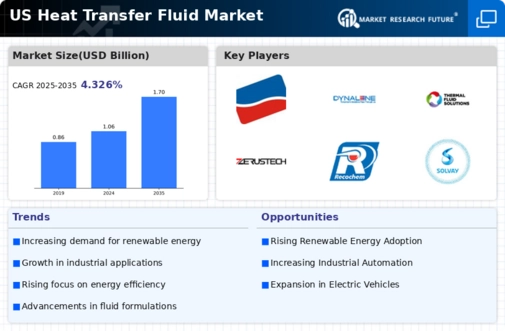Growth in HVAC Systems
The heat transfer-fluid market is benefiting from the growth of heating, ventilation, and air conditioning (HVAC) systems. As urbanization continues to rise, the demand for efficient HVAC solutions is increasing, leading to a higher requirement for effective heat transfer fluids. In 2025, the HVAC sector is projected to contribute significantly to the heat transfer-fluid market, with an estimated growth rate of 6% annually. This trend suggests that advancements in HVAC technology will further propel the demand for specialized heat transfer fluids, enhancing overall system performance and energy efficiency.
Rising Industrial Applications
The heat transfer-fluid market is experiencing growth due to increasing industrial applications across various sectors. Industries such as chemical processing, food and beverage, and pharmaceuticals are utilizing heat transfer fluids for efficient thermal management. The demand for these fluids is projected to rise as industries seek to enhance operational efficiency and reduce energy consumption. In 2025, the market is expected to reach a valuation of approximately $3 billion, driven by the need for effective heat transfer solutions. This trend indicates a robust expansion of the heat transfer-fluid market, as companies invest in advanced thermal management systems to optimize production processes.
Increased Focus on Energy Efficiency
The heat transfer-fluid market is driven by an increased focus on energy efficiency across various sectors. Companies are actively seeking ways to reduce energy consumption and operational costs, leading to a higher demand for advanced heat transfer fluids that offer superior thermal conductivity and stability. This trend is particularly evident in manufacturing and industrial processes, where optimizing heat transfer can lead to significant cost savings. The market is expected to grow as businesses prioritize energy-efficient solutions, potentially leading to a market size increase of 5% annually in the coming years.
Emerging Renewable Energy Technologies
The heat transfer-fluid market is expected to grow due to emerging renewable energy technologies. As the US shifts towards sustainable energy sources, the demand for heat transfer fluids in solar thermal systems and geothermal applications is likely to increase. These technologies require efficient heat transfer solutions to optimize energy production. The market could see a surge in investment as companies seek to develop innovative fluids that can withstand high temperatures and provide superior thermal performance. This trend indicates a promising future for the heat transfer-fluid market as it aligns with the broader energy transition.
Regulatory Compliance and Safety Standards
The heat transfer-fluid market is influenced by stringent regulatory compliance and safety standards imposed by government agencies. These regulations necessitate the use of fluids that meet specific environmental and safety criteria, prompting manufacturers to innovate and develop safer, more efficient products. The market is likely to see a shift towards fluids that are not only effective but also environmentally friendly. As regulations evolve, companies in the heat transfer-fluid market must adapt to maintain compliance, which could lead to increased operational costs but also drive innovation in product development.






















Leave a Comment